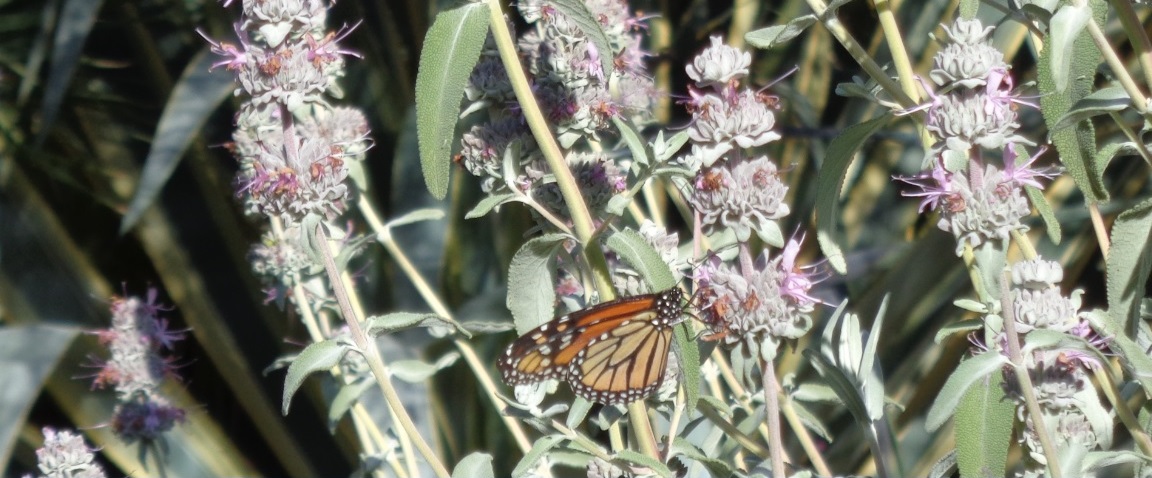Nature Paintings & Poetry

Painting by Carla Bollinger, Sierra Club member
Oaks
Poem by Carla Laureen Bollinger
Downpour for days, moisture
seeps deep through roots.
Mist and fog spread like butter
cradled in valleys and up hillsides.
Sun splits the veil of dawn –
Exposing leaves dripped in frost.
Soon daylight grows long,
dry wind whips across meadow.
Oaks’ offspring fall from curlicue
branches, a thunderous descent
in woodlands for squirrels
to gather and store for sparse times.
Humans rest under dappled light,
shade cools the brow –
stories old and new are shared
as Jay squawks and eagle builds nest.
After all chores are done,
Earth’s pavilion is moon lit –
Oak trees in shimmering petticoats
waltz along the ridge.

River in the Sierras -- photo by Gayle Dufour
Daybreak
Poem by Virginia Hutchinson
Night swallowed stonehill.
She traveled to the valley,
and black water river.
Currents ran deep, still,
and as if magnetized,
pulled her into its body.
The water surging, closed
around her, swirling
in a black hole falls,
until white mist
like old hands from beyond
the other shore, touched her.
Then she breathed again,
as morning came back
and awakened her.
She felt new dawn comforting,
smelled the soft grass’ newness,
tasted air, moist on her tongue,
saw the monarchs hover, weightless,
as daybreak cleared in its own way.
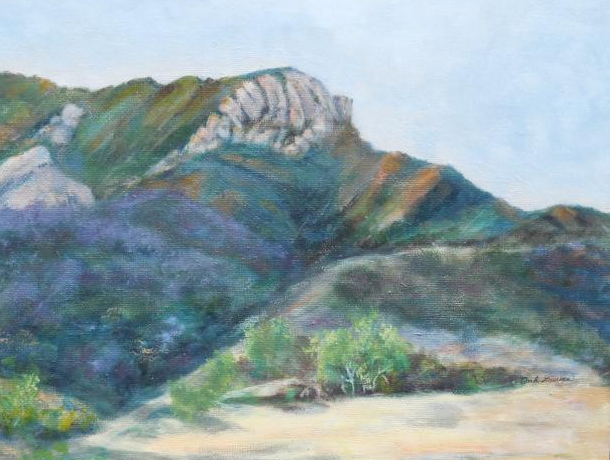
Boney Mountain, Painting by Carla Bollinger
THE MOUNTAIN
Poem by Virginia B. Anderson
Listen!
Is not The Mountain
full of mystery as it
whispers into dawn?
Its dark breath full of voices?
The languages it knows?
The way it never tells
the rabbit of the fox?
Nor the fox of the rabbit?
Watch how it sheds its night shirts
one by one!
Have you ever seen anything
as sensuous as this mountain softening into light?
Is it not the inside
of the outside of the world?

"Scenes in the Santa Susanas" -- painting by Carla Bollinger
SANTA SUSANA MOUNTAINS
Poem by Erica Stux
Craggy sandstone cliffs,
cleaved by cracks,
corroded by rain,
contoured by wind,
overlook the valley,
where broken blocks
lie scattered, like
giant puzzle pieces.

"Part of Garden of the Gods in the San Fernando Valley" -- Photo by Carla Bollinger

Painting by Carla Laureen Bollinger
Legend of Red-tailed Hawk
Poem by Carla Bollinger
Inspired by Dennis Garcia, Chumash Storyteller
Shadow covered Earth for many seasons.
Animals grew silent and food became scarce.
Chumash warriors,
tribal women and men,
climbed to the tallest mountain --
called upon Sun God
to chase away dark spirits.
Small warrior followed others --
used his wings to split the clouds
until sunlight reappeared.
Sun shone on Hawk
shared his fire,
giving him the gift of a red tail.
Hawk's tail feather tips
blackened by sun's flames
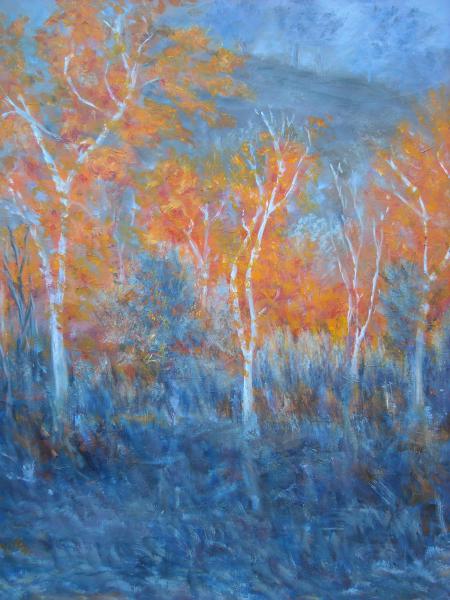
Painting by Carla Bollinger
Changes
Poem by Virginia Hutchinson
Such grace thru’ cherry blossoms
swirls before the sunset fades
Monarchs flutter and twirl the air
dance pirouettes and leaps
Images reflect and ripple
upon the Tidal Basin
Petals join the ballet fall and spin
ignite the twilight
Then slowly descend
to rest on a pink floor
The dancers glide on wisp
of fading light
I stand and watch awhile
as the troupe surrenders
to the wrath
of angry wind.
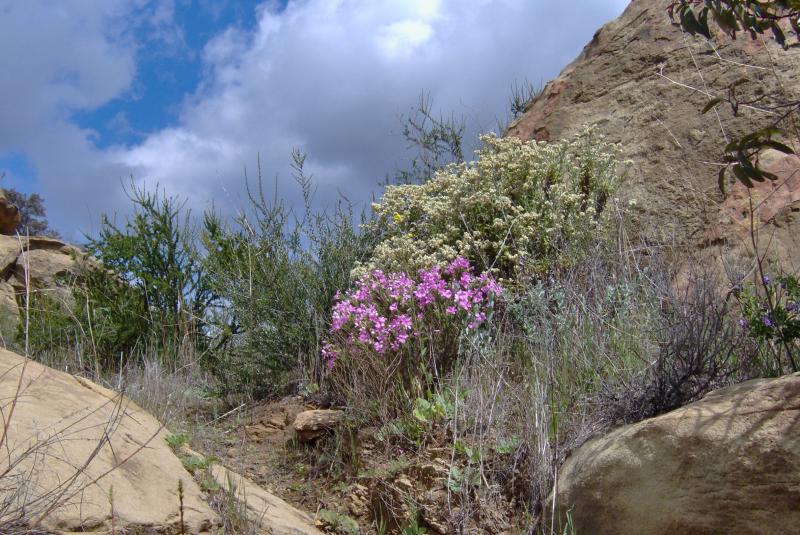
"Purple Profusion" -- photo by Henry Bollinger
ROCK SONGS
Poem by Carla Laureen Bollinger
Tears can only flow so long;
even rocks shatter after
furies of fate unleash --
lines deepen expose black slag
elongate into complete darkness.
Sleep comes in damaged dreams --
awaken to see orange brush strokes
on rocks scattered down mountain
sides' chaotic rubble
Amongst these stones, gardens grow,
mallow, buckwheat, wild flowers
shoot through their split souls.
I yield to a symphony of voices --
Come sit, tell us your stories
say the rocks,
.until you can talk no more.
Cartoon by Willis Simms

Woodlands Lost
In the magic woodlands
one of our voices echoed
"Here I come ready or not."
My brothers, other kids,
scattered, hid. Our bodies
straight shoulder to tree trunk
or flat down behind a
lightning struck tree --
cheeks pressed against
buttery grass and leaves.
Under oaks, birch,
and maples' canopy
found hiding, chased,
our laughter swooshed
through dappled light.
Then they came. The men.
I could hear their buzz saws
early morning and throughout
each day. Days and days of
saws starting up, blasting,
mens' voices shouting,
trees down and afterwards
tree bodies hauled away.

"Chatsworth Nature Preserve Ecology Pond" -- Painting by Carla Bollinger
Colorful History of Chatsworth Nature Preserve – Reservoir
By Carla Bollinger, Chatsworth Nature Preserve Coalition Delegate
The Chatsworth Nature Preserve (CNP) and the surrounding area was once the home of Native Americans. The CNP and surrounding Simi Hills-Santa Susana Mountain foothills was also a convergence site for the Fernandiño, Gabrieleño and Ventureño Chumash. These Native Americans gathered together for ceremonies, trading, and inter-marriages. This was a time when the grizzly bears, deer, cougars, and many other wildlife were in abundance. The emergence of Europeans, Spaniards, and the early Mission Period (1769-1833), changed the landscape forever. Cattle, sheepherding, horse ranching, farming, all domestic activity altered the native grasses. Wildlife was hunted, eventually causing the dispersal or in the case of the grizzly bear, extinction, and all other wildlife, too, became scarce.
After the San Fernando Mission and all California missions became secularized (1834-1836), land parcels, Rancheros, were either sold or given to private citizens by Governor Pio Pico. The largest land grant in California, the Ex-Mission San Fernando land plat, 116,858 acres encompassed most of the San Fernando Valley. Cattle ranching, sheepherding, horse ranches and in the late 19th century, dry farming wheat and barley became the San Fernando Valley industries which included the Chatsworth Nature Preserve-Reservoir.
William Mulholland brought water to San Fernando Valley-Los Angeles and for better or worse, this changed an all agricultural-ranching landscape to a growing residential-industrial, and movie—TV filming community. The Chatsworth Reservoir, built and put into operation in 1919, the 19th , and last built to support the Owens Valley-Los Angeles Aqueduct System, supplied the SFV agricultural industry with water. Although planned for expansion in 1969, after the 1971 Sylmar Earthquake, engineers felt the reservoir was unsafe for expansion or continued use. The reservoir was retired.
Activist, Jan Hinkston, founder of the Santa Susana Mountain Park Association (SSMPA), Jean Searle of the Sierra Club, and other environmentalists launched a campaign to save open space/parkland in the northwest part of the San Fernando Valley, targeting first the Chatsworth Reservoir. Jan was driven to her activism by seeing hundreds of oak trees on the north end of the Chatsworth Reservoir cut down for residential development. In Hinkston’s words: “One morning I drove by the Chatsworth Reservoir on my way to school, and was appalled by the hundreds of ancient oaks laying severed on the ground on the north side along Valley Circle Blvd. I couldn’t believe such a violent thing could occur in this day and age without warning – for what reason?”
In 1974 the Department of Water and Power (DWP) and California Fish and Game, worked together to create the “Ecology Pond”, reservoir detention basin #2, to support the migratory birds and residential birds, all wildlife. Led by many environmentalists and Hal Bernson, Councilmember, 12th District, the Chatsworth Reservoir became the Chatsworth Nature Preserve, Ordinance #169723, effective June 12, 1994. Even with this ordinance in place, the CNP has been threatened with development and has undergone periods of mismanagement as a nature preserve. Yet, it remains a wildlife refuge at the edge of the Simi Hills.
Many people have wanted to see the CNP be more open to the public. Some people would like to have hiking trails, horse trails, or bring their dogs inside. This human activity will destroy the natural setting, unique in the Greater LA area, and the habitat for wildlife that live or “visit” there. For instance, during spring nesting season, birds would not continue to nest in the Ecology Pond marsh if humans, dogs, and horses, were to use the area.
The Ordinance allows for scientific field studies. The Southwestern Herpetologists, SFV Audubon Society, Sierra Club-Canada Goose Project, and California Native Plant Society, have for years conducted studies, counts, and research in the CNP. The public is invited to the DWP sponsored CNP Earth Day Open House on April 12. It’s an opportunity to see this last remnant of early San Fernando Valley in a natural environment before urban sprawl devoured all the land parcels.
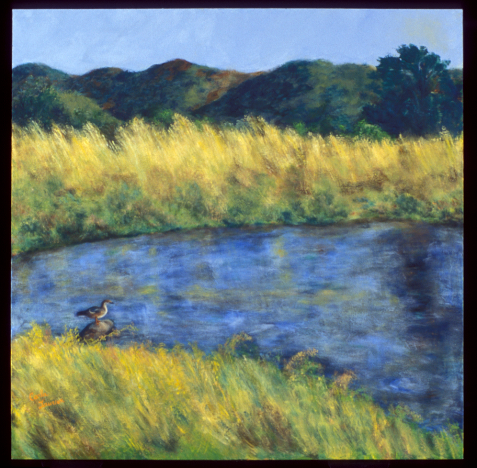
Painting by Carla Bollinger
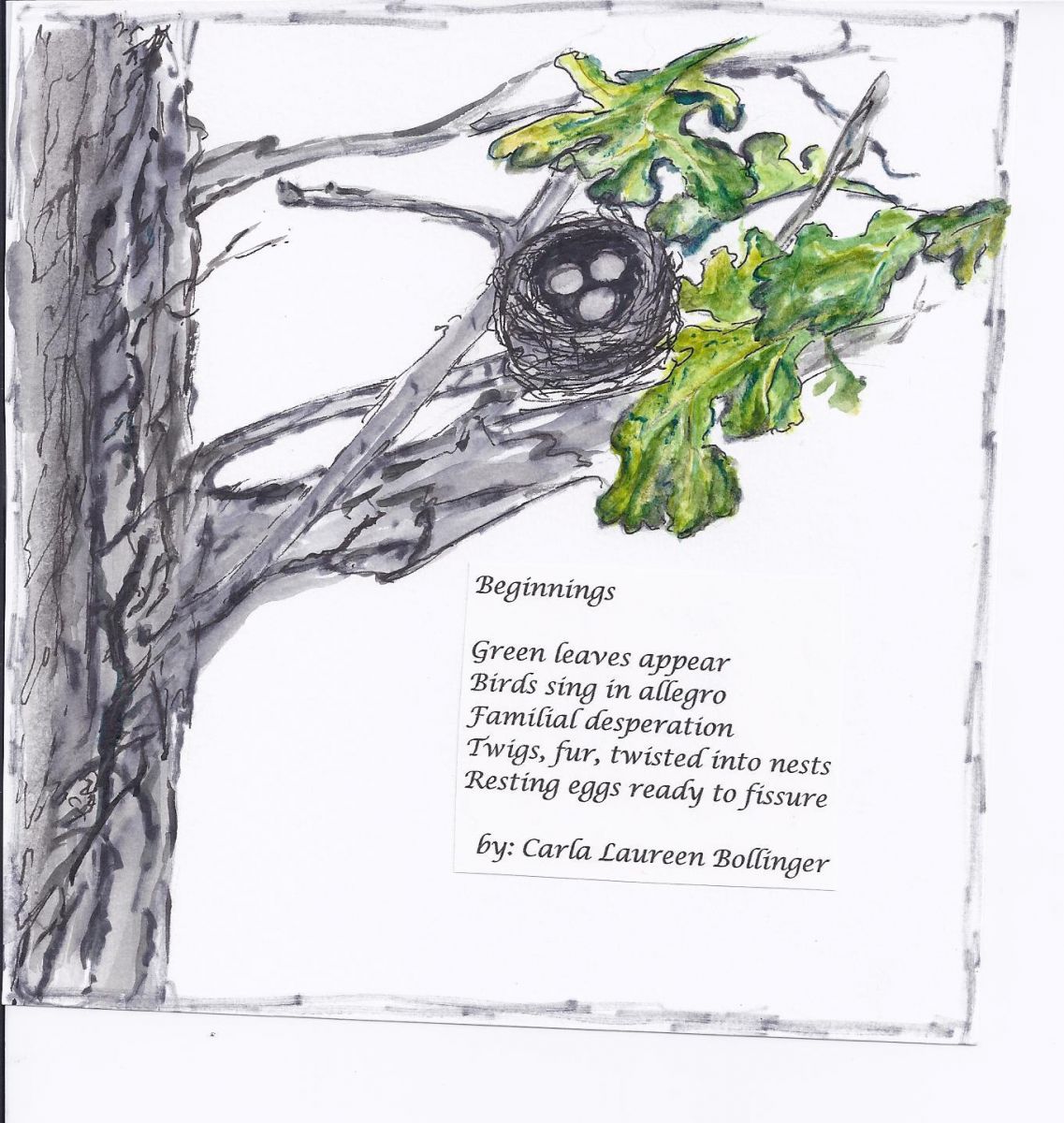
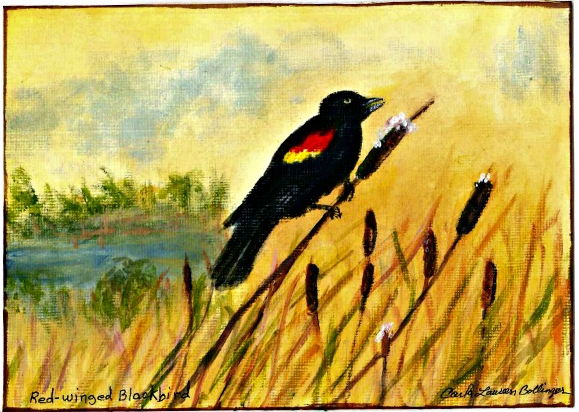
Painting & writeup by Carla Bollinger
Male Red-Winged Blackbirds
Agelaius phoeniceus
Male red-winged blackbirds are striking in appearance, red shoulder patch, with yellow border. Females are plain brown-streaked. Habitat: marshes and meadows. Seen in Chatsworth Nature Preserve Ecology Pond marsh on cattails and reeds. Range from southern Alaska to northern Canada to Mexico, coast-to-coast.
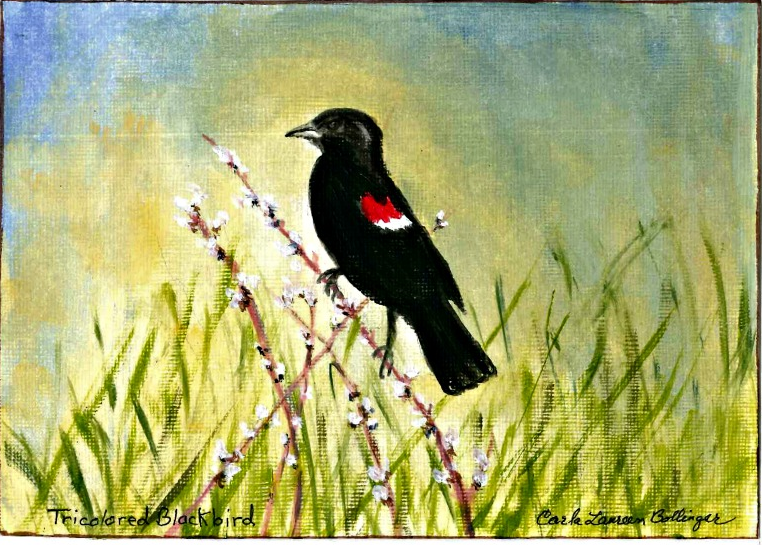
Painting & writeup by Carla Bollinger
Tricolored Blackbird
Agelaius tricolor
Male tricolored blackbirds are black with a red shoulder patch, white border. Females are blackish-brown streaked. Habitat: marshes and grasslands. Rare species, range: California. In 70 years population decline is 80% due to loss of habitat. Nest in Chatsworth Nature Preserve. Last seen 2006. CA Fish & Wildlife: Species of special concern. Priority 1.
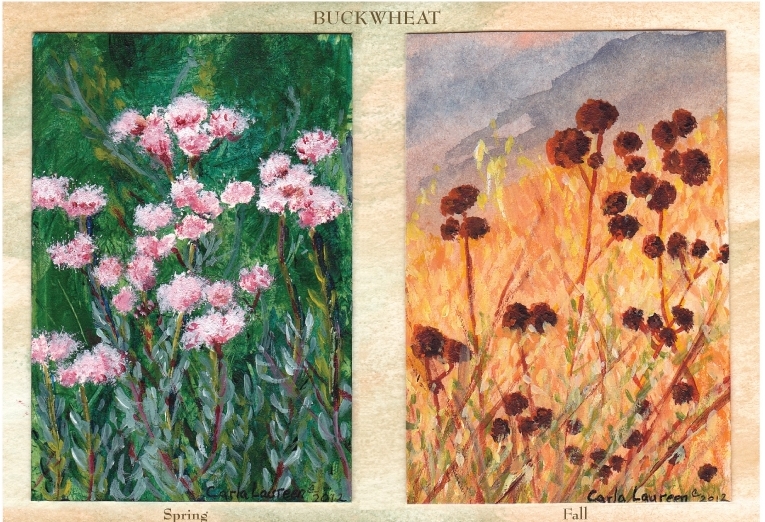
Painting by Carla Bollinger
Buckwheat grows abundantly in the Santa Susana/Simi Hills

"Santa Susana Bush Monkey Flower" -- Painting by Carla Bollinger
A perennial with tubular at the base velvet red flowers found growing in rock outcroppings, under oak woodlands, serpentine cliffs, and near seasonal springs in decomposed granite in the Simi Hills-Santa Susana Mountains. The monkey Flowers bloom in spring from March to June. There is also a rare integrating form of Monkey Flower with variegated yellow to red flowers. Monkey flowers attract bees and hummingbirds. Native Americans used the plants foliage as a soothing poultice for minor burns and skin irritations.
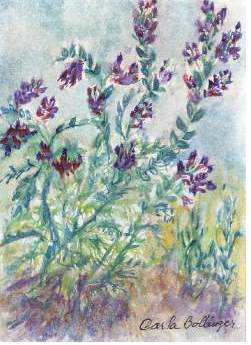
"'Milk Vetch" -- Santa Susana/Simi native plant -- Painting by Carla Bollinger
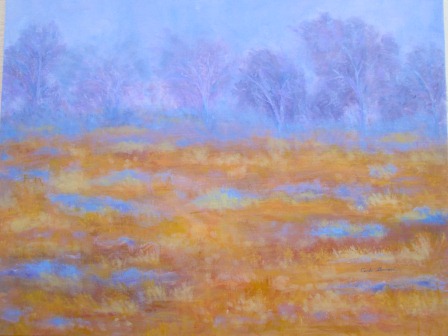
Painting by Carla Bollinger
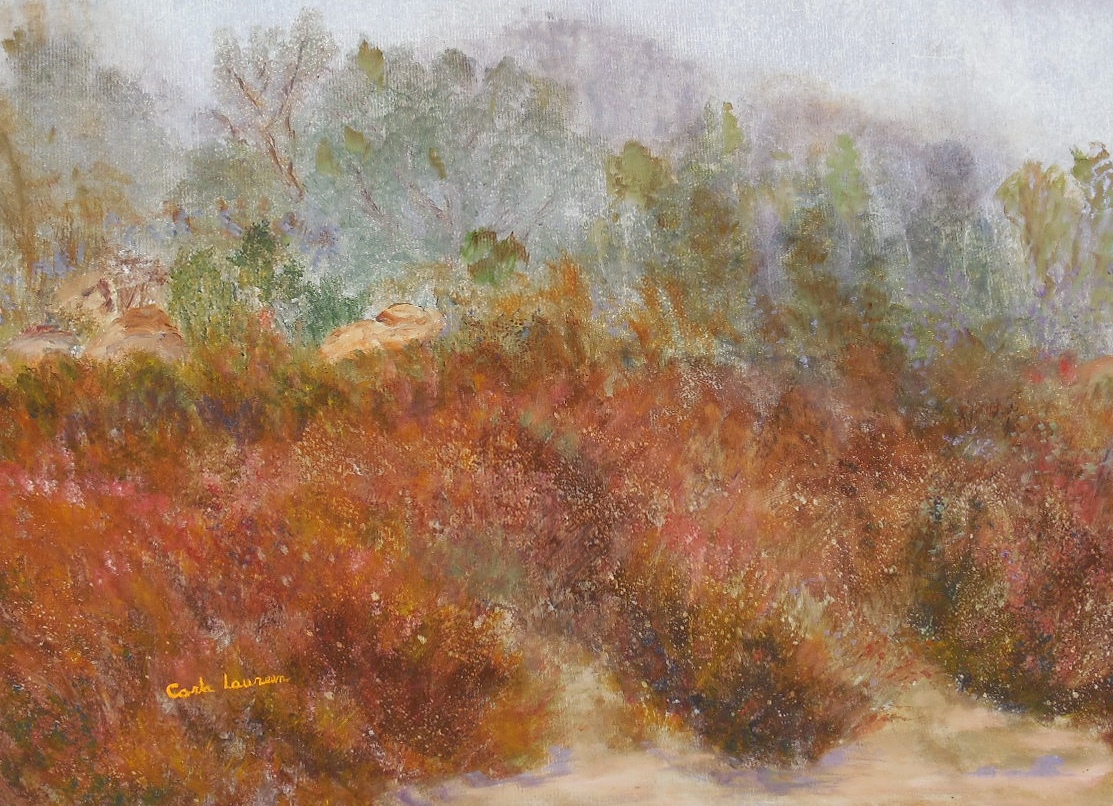
Painting by Carla Bollinger

